When I’d told Ana that one of the places I was eager to see was the Jardim Bordallo Pinhero, she reacted almost giddily – telling me this choice, combined with my preference for Sagres beer, practically made me an honorary Lisboeta. Of course, this meant the Pinhero Garden was a place I couldn’t miss.
Even though I needed to walk off some of my lunch, when the Herewego app confirmed that the walk from the restaurant to the garden exceeded five kilometers and finished 70 meters higher than my staring point, I knew I’d opt for a combination of Metro and a walk. It looked like the Campo Pequeno stop was a bit more than halfway and, given how much I’d walked in the morning, two kilometers or so seemed appropriate.
Just steps from the Metro is the actual Campo Pequeno – an old bullfighting ring that provides the name for the Metro stop but, more importantly, is considered one of the most important Lisbon buildings designed in the Neo-Arabic style. From there, I trusted the GPS to direct me to the Jardim Bordallo Pinhero.
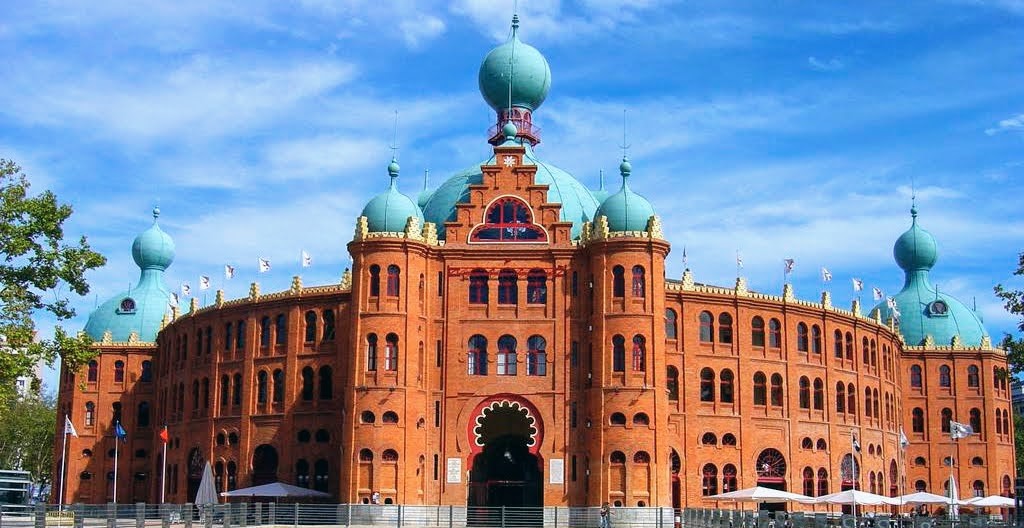
(Here’s the third GPS rant: The directions are sometimes confusing, often too specific when they needn’t be, and not specific enough when they need to be. This walk provides several examples. As I approached a roundabout, the directions instructed me to use the third exit. This is correct if, as a pedestrian I followed the vehicular direction of the traffic. Following a more pedestrian friendly direction, I’d use the first exit. The street onto which I was to proceed, Campo Grande is a road divided by a park and it enters the circle twice. The directions had me walking with the traffic flow in the roundabout but against the traffic flow on Campo Grande. The next kerfuffle came when it instructed me to turn right then left which is technically what I did for a total of about 25 meters but essentially I was continuing straight on Campo Grande. ARRRRGH!)
One L or two?
In my albeit limited research, I failed to discover much about the life and personality of the man who was born Raphael Bordallo Pinheiro but whose name is now orthographized as Rafael Bordalo Pinheiro. However, judging by the nature of his work, I think any spelling confusion would have amused him. Born in 1846, Bordalo died in 1905 six years before the first Portuguese Republic began its process of orthographic reform and standardization. Thus, the museum dedicated to his work is the Museu Bordalo Pinheiro while the garden a few hundred meters away that has replicas of his ceramics displayed at the 1889 Exposition Universelle (that also saw the debut of the Eiffel Tower) is the Jardim Bordallo Pinhero.
Bordalo’s scant biography on the museum’s website describes him as “devoting himself to graphic arts, visual arts, ceramics, object design and decoration, producing a vast body of work that almost always critically reflected the day-to-day cultural, political and social life of the time in which he lived” and “innovative, developing humorous drawings and cartoons as a form of artistic expression.”
You reach the Bordallo Garden by walking through the atrium and courtyard of the Palácio Pimenta (Pepper Palace) which is the City Museum of Lisbon. And while the courtyard is lovely
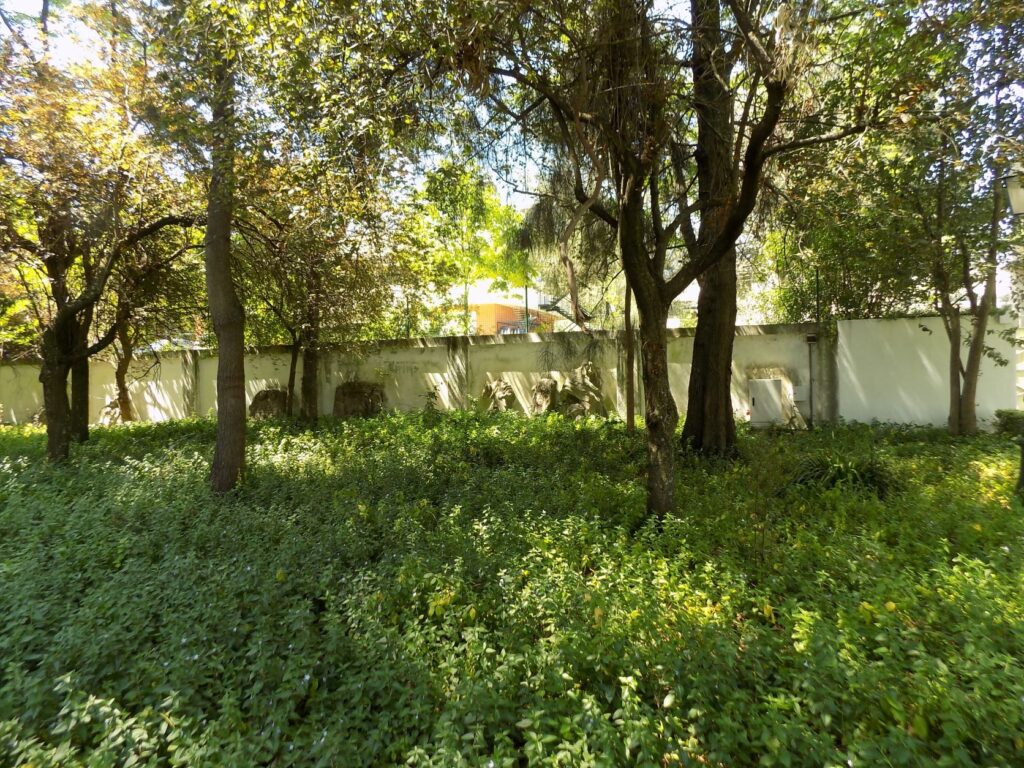
What strikes you immediately is this remarkable sound
(Attribution 4.0 International [CC BY 4.0])
and you quickly discover the source.

Yes, both gardens are populated with wild roaming peacocks and peahens though I could never learn why.
An unassuming passage leads to Pinheiro’s section and it holds surprises and marvels at every turn. From the massive bee greeting you from the circular hedge
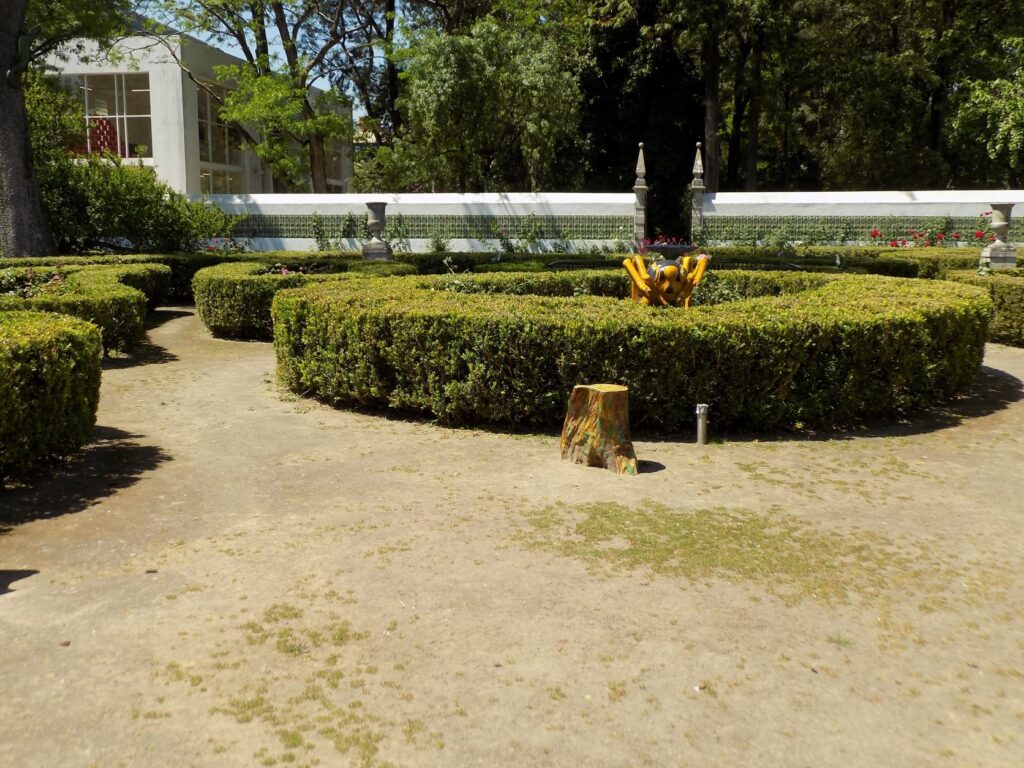
to the monkeys dangling from a tree

you need to keep your eyes alert at all times as these photos show. Whimsy and magic.
Legal graffiti
You might recall that describing one of my earliest impressions of Cascais I wrote, “In walking about the city, I noted that while graffiti was abundant, the streets were essentially litter free – a situation I found repeatedly throughout the country.” This was even more the case in Lisbon.
Apparently, the problem had become endemic and the city was in a losing battle not only trying to keep buildings clear of graffiti but trams, vans, and nearly any stationary object that could become the target of public art or defacement. Remember the tram I rode to Bairro Alto? The car I rode
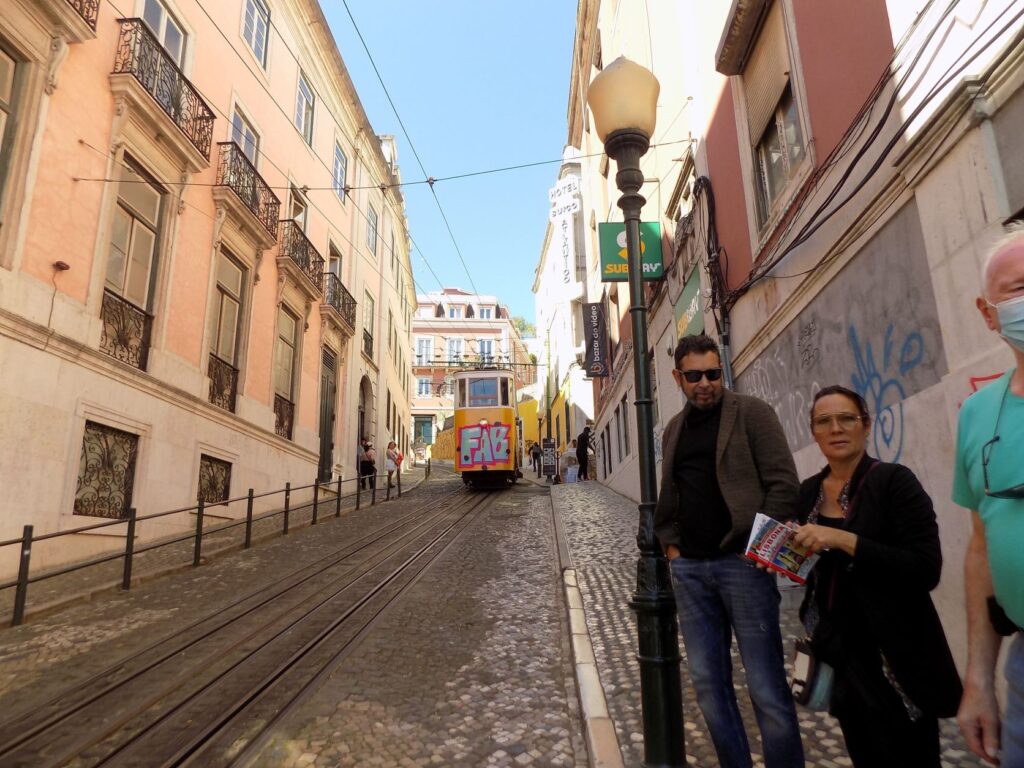
was relatively clean compared with some others such as this one.
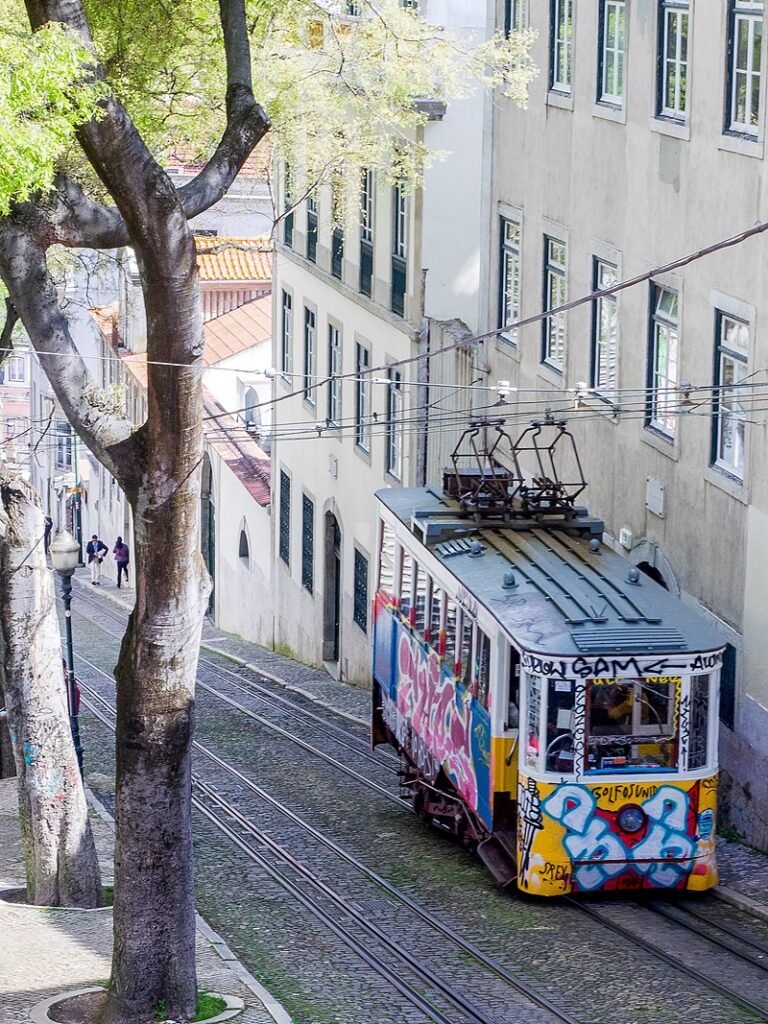
OLYMPUS DIGITAL CAMERA
(Wikimedia Commons By Ajay Suresh CC BY 2.0)
So, in 2008, the city council decided to take a different approach by establishing the Galeria de Arte Urbana (GAU) or Urban Art Gallery. It was, in fact, along this very passage, the Calçada da Glória, that they established the first space for legal street art. Now, not only does the city work with established street artists such as Vhils (Alexandre Farto), André Saraiva, and Bordalo II but also with people who would have once been considered vandals. In fact, the city’s Department of Heritage, now has a street art division.
Given some historical perspective, this shouldn’t be a particularly surprising approach. Lisbon has decorated the exterior of its buildings for centuries usually using the blue ceramic tiles (azulejos) for which the city is justifiably famous. The magazine Lisbon Lux published this story on the 10 most beautiful tile facades in Lisbon. While tiles are certainly less ephemeral than most 21st century street art, the tradition was so well established that many buildings used these designs in defiance of the Marquis de Pombal’s rebuilding plans. So, in a sense, even some of the tiled buildings in Lisbon have an anti-establishment aspect to them.
Walking around Lisbon, you simply need to keep you eyes open and you can encounter street art everywhere. Some of it, like this one I spotted walking through Alfama,
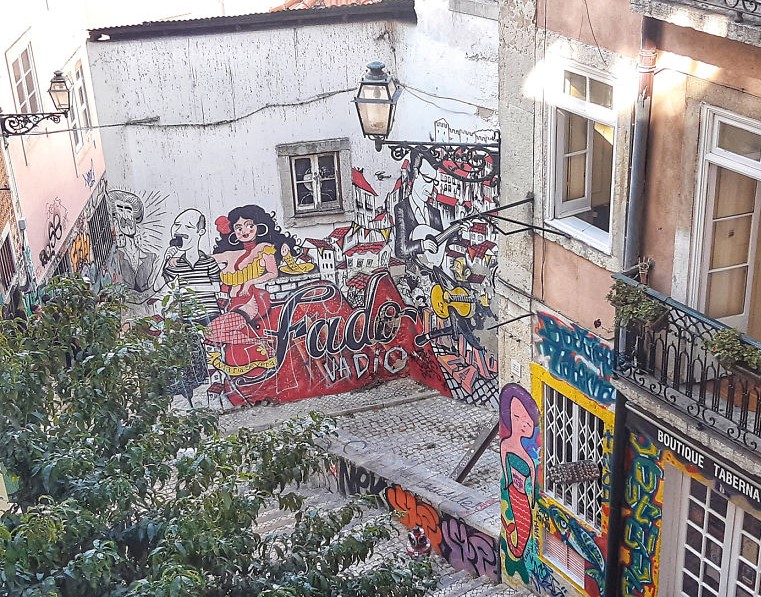
is rather spectacular.
So it was, with the guidance of the website Spotted By Locals, I set out to see some of their recommendations. In the end, they were both fascinating and disappointing. For example, this painting in Picoas (as photographed by Nuno Lopes de Paula)

where you can clearly see the king using the straw to suck out the resources of the Amazon, now looks like this.
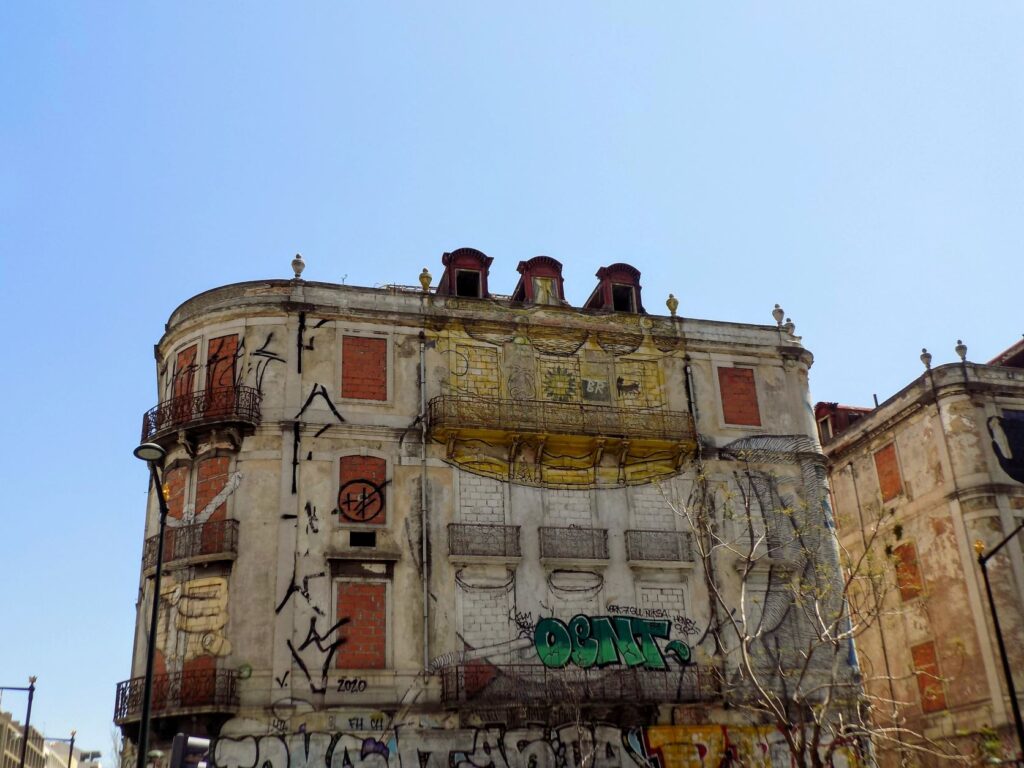
Even the graffiti isn’t safe from graffiti.
I found much the same situation at one of the oldest sites sponsored by the GAU – the Amoreiras Wall. Some of the art was intact
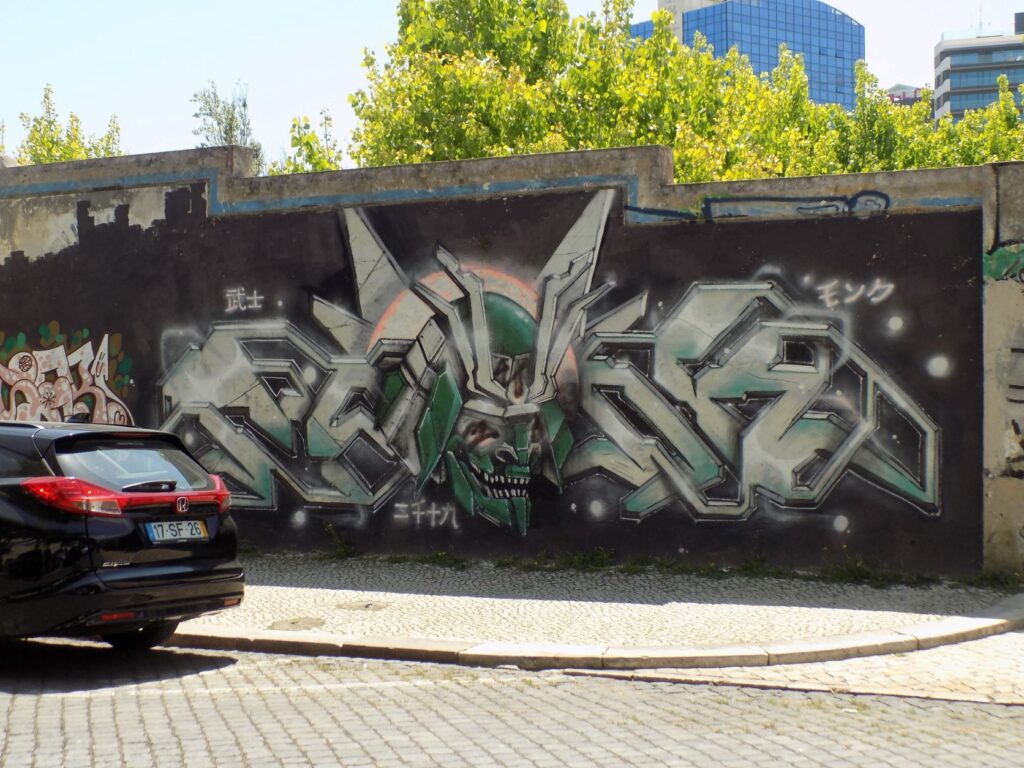
and some sadly defaced.

The rest of the afternoon’s photos are here.
Food, glorious food! Part Two
It had been a long day and I’d walked a lot. In fact, by day’s end, and if my phone’s fitness app is to be believed, I had walked about 17 kilometers (a little more than 10.5 miles). So, when I asked my new friend, Cláudio (the doorman at the hotel), for a recommendation, of someplace close by, I was happy to take it. After my meal at Fornino Saloio, I was doubly happy. This was among my favorite meals in Portugal. I have to admit that while his directions were quite good, the place was so small and unassuming that I walked by it twice. (This wouldn’t have been the case had I arrived after 21:00 because by then there was quite a line waiting for a table.)
I started with what the menu listed as an apple and poultry sausage but it wasn’t in a casing. It was more like a hash. Still, it was delicious. I had, of course, grilled cod that was served with grilled potatoes and a typical Portuguese salad of a little lettuce, sliced onion, sliced tomato, and sometimes a bit of shredded carrot. (Interestingly, some Lisbon residents refer to themselves not only as Lisboetas but as alfacinhas or lettuces. No one knows the origin of the nickname. About the only thing people can agree on is that the word comes from the Moors because in Arabic lettuce is al-hassa.)
From there, it was a quick trip (with a little more walking) on the Metro to Rossio where I walked up to A Ginjinha for a quick shot of ginjinha com (with the cherries), then down to Manteigaria for two of their unique pasteis de nata that I carried back to the hotel and set aside while I packed my suitcase. Although I’d potentially have a few hours for one final wander about Lisbon in the morning, I had a flight to Vienna in the afternoon.
I took a few moments to breathe, stretched my legs, and, since I don’t like coffee, enjoyed my pastries with a glass of port. My thoughts wandered briefly to Zicomo but since the vet had maintained email silence, I tried to remain optimistic that he was recovering. When, at last, I turned off the light Thursday had turned to Friday and I thought, after midnight, I am an innocent man.
Nothing like 2 pastries with a shot of Port before a noon time start…
on any given day in Lisbon Todd.
Sorta makes going to-
the airport for the flight to Vienna all that more entertaining.
P & P for me- Port and pastries sorta breakfast of champions.
Nice read-
Shell
Ginjinha, pasteis de nata, and port. Three of my Portuguese favorites.